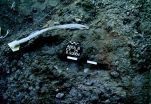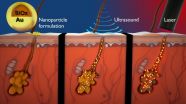(Press-News.org) Some 2.5 million years ago, early humans survived on a paltry diet of plants. As the human brain expanded, however, it required more substantial nourishment - namely fat and meat - to sustain it. This drove prehistoric man, who lacked the requisite claws and sharp teeth of carnivores, to develop the skills and tools necessary to hunt animals and butcher fat and meat from large carcasses.
Among elephant remains some 500,000 years old at a Lower Paleolithic site in Revadim, Israel, Prof. Ran Barkai and his graduate students Natasha Solodenko and Andrea Zupanchich of Tel Aviv University's Department of Archaeology and Ancient Near Eastern Cultures recently analyzed "handaxes" and "scrapers," universally shaped and sized prehistoric stone tools, replete with animal residue.
The research, published recently in PLOS ONE, represents the first scientifically verified direct evidence for the precise use of Paleolithic stone tools: to process animal carcasses and hides. The research was done in collaboration with Drs. Stella Ninziante Cesaro and Cristina Lemorini of La Sapienza, University of Rome, and Dr. Ofer Marder of Ben-Gurion University of the Negev.
Putting the puzzle together
"There are three parts to this puzzle: the expansion of the human brain, the shift to meat consumption, and the ability to develop sophisticated technology to meet the new biological demands. The invention of stone technology was a major breakthrough in human evolution," Prof. Barkai said. "Fracturing rocks in order to butcher and cut animal meat represents a key biological and cultural milestone.
"At the Revadim quarry, a wonderfully preserved site a half-million years old, we found butchered animal remains, including an elephant rib bone which had been neatly cut by a stone tool, alongside flint handaxes and scrapers still retaining animal fat. It became clear from further analyses that butchering and carcass processing indeed took place at this site."
Through use-wear analysis -- examining the surfaces and edges of the tools to determine their function -- and the Fourier Transform InfraRed (FTIR) residue analysis which harnesses infrared to identify signatures of prehistoric organic compounds, the researchers were able to demonstrate for the first time direct proof of animal exploitation by flint tools.
"Archaeologists have until now only been able to suggest scenarios about the use and function of such tools. We don't have a time machine," Prof. Barkai said. "It makes sense that these tools would be used to break down carcasses, but until evidence was uncovered to prove this, it remained just a theory."
A prehistoric Swiss army knife
While the question of their function and production remained unanswered until now, there was little doubt that the handaxe and scraper, found at prehistoric sites all around the world, were distinct, used for specific purposes. By replicating the flint tools for a modern butchering experiment, and then comparing the replicas with their prehistoric counterparts, the researchers determined that the handaxe was prehistoric man's sturdy "Swiss army knife," capable of cutting and breaking down bone, tough sinew, and hide. The slimmer, more delicate scraper was used to separate fur and animal fat from muscle tissue.
"Prehistoric peoples made use of all parts of the animal," said Prof. Barkai. "In the case of the massive elephant, for example, they would have needed to use both tools to manage such a challenging task. The knowledge of how to make these tools was precious, and must have been passed along from generation to generation, because these tools were reproduced the same way across great territorial expanses and over hundreds of thousands of years.
"In this thousand-piece puzzle called archaeology, sometimes we find pieces that connect other pieces together. This is what we have found with the stone tools and animal bones."
INFORMATION:
American Friends of Tel Aviv University supports Israel's most influential, most comprehensive and most sought-after center of higher learning, Tel Aviv University (TAU). US News & World Report's Best Global Universities Rankings rate TAU as #148 in the world, and the Times Higher Education World University Rankings rank TAU Israel's top university. It is one of a handful of elite international universities rated as the best producers of successful startups, and TAU alumni rank #9 in the world for the amount of American venture capital they attract.
A leader in the pan-disciplinary approach to education, TAU is internationally recognized for the scope and groundbreaking nature of its research and scholarship -- attracting world-class faculty and consistently producing cutting-edge work with profound implications for the future.
DENVER, March 23, 2015 -- Since HIV emerged in the '80s, drug "cocktails" transformed the deadly disease into a manageable one. But the virus is adept at developing resistance to drugs, and treatment regimens require tweaking that can be costly. Now scientists at the 249th National Meeting & Exposition of the American Chemical Society (ACS) are announcing new progress toward affordable drugs that could potentially thwart the virus's ability to resist them.
ACS, the world's largest scientific society, is holding the meeting here through Thursday. It features nearly 11,000 ...
Washington, D.C.--To combat global climate change caused by greenhouse gases, alternative energy sources and other types of environmental recourse actions are needed. There are a variety of proposals that involve using vertical ocean pipes to move seawater to the surface from the depths in order to reap different potential climate benefits. A new study from a group of Carnegie scientists determines that these types of pipes could actually increase global warming quite drastically. It is published in Environmental Research Letters.
One proposed strategy--called Ocean ...
What if there were a pill that made you more compassionate and more likely to give spare change to someone less fortunate? UC Berkeley scientists have taken a big step in that direction.
A new study by UC Berkeley and UC San Francisco researchers finds that giving a drug that changes the neurochemical balance in the prefrontal cortex of the brain causes a greater willingness to engage in prosocial behaviors, such as ensuring that resources are divided more equally.
The researchers also say that future research may lead to a better understanding of the interaction between ...
URBANA, Ill. - Over the last several decades there have been substantial yield improvements in soybean. Because of new varieties and new agronomic practices, the yield potential in soybean is higher now than ever before. But a lack of updated information on the nutritional needs of soybean crops may be limiting the crop's potential.
Researchers from the University of Illinois Crop Physiology Laboratory led by Fred Below have recently provided an updated set of nutrition needs for soybean, identifying exactly which nutrients the plant needs, when those nutrients are accumulated ...
Acne, a scourge of adolescence, may be about to meet its ultra high-tech match. By using a combination of ultrasound, gold-covered particles and lasers, researchers from UC Santa Barbara and the private medical device company Sebacia have developed a targeted therapy that could potentially lessen the frequency and intensity of breakouts, relieving acne sufferers the discomfort and stress of dealing with severe and recurring pimples.
"Through this unique collaboration, we have essentially established the foundation of a novel therapy," said Samir Mitragotri, professor ...
Our eyes are drawn to several dimensions of an object--such as color, texture, and luminance--even when we need to focus on only one of them, researchers at New York University and the University of Pennsylvania have found. The study, which appears in the journal Current Biology, points to the ability of our visual system to integrate multiple components of an item while underscoring the difficulty we have in focusing on a particular aspect of it.
"Even when we want and need to focus on one dimension of things we come across every day, such as the texture of your cat's ...
For in vitro fertilization and other assisted reproductive technologies, selecting the healthiest and best swimming sperm from a sample of semen can dramatically increase success. Microfluidics--micro-scale technologies that were originally developed to enable high-throughput gene sequencing and for Point-Of-Care diagnostics--are now being adapted to enhance sperm sorting. These new methods, reviewed by engineers in the journal Trends in Biotechnology, are generating promising results in applications such as single-sperm genomics, in-home male fertility testing, and wildlife ...
A combination of human stem cell transplantation and antidiabetic drugs proved to be highly effective at improving body weight and glucose metabolism in a mouse model of type 2 diabetes. The findings, published March 19th by Stem Cell Reports, could set the stage for clinical trials to test the first stem cell-based approach for insulin replacement in patients with type 2 diabetes.
Type 2 diabetes, which accounts for 90%-95% of the now approaching 400 million cases of diabetes worldwide, is currently treated by oral medication, insulin injections, or both to control blood ...
Altered signaling through the vitamin D receptor on certain immune cells may play a role in causing the chronic inflammation that leads to cardiometabolic disease, the combination of type 2 diabetes and heart disease that is the most common cause of illness and death in Western populations. The research appears March 19 in the journal Cell Reports.
"Because low vitamin D levels are associated with diabetes and heart disease, we looked at the connections between vitamin D, immune function, and these disease states," says senior author Carlos Bernal-Mizrachi, of the Washington ...
Scientists at the University of British Columbia and BetaLogics, part of Janssen Research & Development, LLC have shown for the first time that Type 2 diabetes can be effectively treated with a combination of specially-cultured stem cells and conventional diabetes drugs.
Stem cells - generic cells that haven't yet taken on specialized form and function - have recently been used by scientists at UBC and elsewhere to reverse Type 1 diabetes in mice. In Type 1 diabetes, which usually begins in childhood, the pancreas produces little or no insulin, the hormone that enables ...



